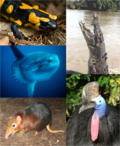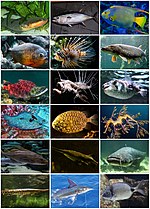Sarcopterygii (/ˌsɑːrkɒptəˈrɪdʒi.aɪ/; from Ancient Greek σάρξ (sárx) 'flesh' and πτέρυξ (ptérux) 'wing, fin') — sometimes considered synonymous with Crossopterygii...
37 KB (2,763 words) - 23:41, 22 October 2024
makes up the vast majority of extant fish) and the lobe-finned fish (Sarcopterygii, which gave rise to all land vertebrates, i.e. tetrapods). The oldest...
32 KB (2,199 words) - 10:58, 26 October 2024
Cladistic classification of Sarcopterygii is the classication of Sarcopterygii as a clade containing not only the lobe-finned fishes (coelacanths and lungfish)...
6 KB (632 words) - 13:12, 11 March 2024
the rest are tetrapods, a terrestrial clade of lobe-finned fishes (Sarcopterygii) who evolved air-breathing using lungs. The name "chordate" comes from...
58 KB (5,211 words) - 01:20, 17 October 2024
successful today: Actinopterygii includes most extant bony fish species, and Sarcopterygii includes the tetrapods. Euteleostomes originally all had an endochondral...
10 KB (710 words) - 10:57, 26 October 2024
Holostei (bowfins and gars) Teleostei (96% of living fish species) Sarcopterygii or lobe-finned fish, which include: Actinistia (coelacanths) Dipnomorpha...
78 KB (7,094 words) - 17:59, 1 November 2024
Middle Devonian period. After Benton, 2004; and Swartz, 2012. Subclass Sarcopterygii Infraclass Tetrapodomorpha Order †Rhizodontida Family †Sauripteridae...
17 KB (724 words) - 05:50, 2 November 2024
tetrapods and lungfishes. Rhipidistia formerly referred to a subgroup of Sarcopterygii consisting of the Porolepiformes and Osteolepiformes, a definition that...
7 KB (500 words) - 23:50, 22 October 2024
Osteichthyes (bony fish) Class Actinopterygii (ray finned fishes) Clade Sarcopterygii (lobe finned fishes, ancestors of tetrapods) The above scheme is the...
4 KB (526 words) - 15:42, 18 August 2024
Jurassic (section Sarcopterygii)
17: 3–13. Clement, Gaël (2005-09-30). "A new coelacanth (Actinistia, Sarcopterygii) from the Jurassic of France, and the question of the closest relative...
234 KB (25,205 words) - 09:36, 2 November 2024
Albinism (section In Sarcopterygii)
Examples of albino laboratory mammals Albinism is the congenital absence of melanin in an animal or plant resulting in white hair, feathers, scales and...
73 KB (8,231 words) - 14:52, 4 November 2024
Fish vary greatly in size. The whale shark and basking shark exceed all other fish by a considerable margin in weight and length. Fish are a paraphyletic...
71 KB (8,319 words) - 04:38, 14 October 2024
List of sarcopterygian genera (redirect from List of Sarcopterygii)
comprehensive listing of all genera that have ever been included in the class Sarcopterygii, excluding purely vernacular terms and Tetrapods. The list includes...
28 KB (676 words) - 21:13, 2 March 2024
lepidotrichia, as opposed to the bulkier, fleshy lobed fins of the sister class Sarcopterygii (lobe-finned fish). Resembling folding fans, the actinopterygian fins...
48 KB (3,774 words) - 15:49, 24 October 2024
(order Coelacanthiformes) are an ancient group of lobe-finned fish (Sarcopterygii) in the class Actinistia. As sarcopterygians, they are more closely...
73 KB (6,345 words) - 03:13, 16 October 2024
Actinopterygii (ray-finned fish, which includes most familiar bony fish) Sarcopterygii Actinistia (coelacanths) Dipnoi (lungfish) Tetrapoda Amphibia (amphibians)...
8 KB (503 words) - 13:33, 8 August 2024
A. Y. (2022). "A new species of rhizodontiform sarcopterygian fish (Sarcopterygii: Rhizodontiformes) from the Lower Carboniferous of the Moscow Region"...
5 KB (409 words) - 16:50, 8 August 2024
Kayenta Formation (section Sarcopterygii)
The Kayenta Formation is a geological formation in the Glen Canyon Group that is spread across the Colorado Plateau province of the United States, including...
70 KB (3,895 words) - 18:31, 18 October 2024
including the ability to breathe air, and ancestral structures within Sarcopterygii, including the presence of lobed fins with a well-developed internal...
40 KB (3,376 words) - 23:46, 19 October 2024
Marise S. S.; Maisey, John G. (2008). "New occurrence of Mawsonia (Sarcopterygii: Actinistia) from the Early Cretaceous of the Sanfranciscana Basin,...
12 KB (1,193 words) - 02:49, 31 August 2024
into two separate groups: the Actinopterygii (or ray-finned fish) and Sarcopterygii (which includes the lobe-finned fish). During the Devonian period a...
47 KB (4,516 words) - 09:42, 21 October 2024
Elrhaz Formation (section Sarcopterygii)
Sarcopterygii Genus Species Material Notes Images Asiatoceratodus A. tiguidiensis Dipnomorph fish. Originally described as Ceratodus tiguidiensis, assigned...
15 KB (970 words) - 01:05, 25 September 2024
Soares, Daphne (ed.). "The Giant Cretaceous Coelacanth (Actinistia, Sarcopterygii) Megalocoelacanthus dobiei Schwimmer, Stewart & Williams, 1994, and...
6 KB (358 words) - 17:23, 14 October 2024
This article contains a list of all of the classes and orders that are located in the Phylum Chordata. The subphyla Tunicata and Vertebrata are in the...
14 KB (1,018 words) - 08:47, 21 October 2024
Amphibia and Amniota within the clade of vertebrates with fleshy limbs (Sarcopterygii). McNeill, J.; et al., eds. (2012). International Code of Nomenclature...
3 KB (295 words) - 03:33, 8 June 2024
the Neoceratodontidae are an ancient family belonging to the class Sarcopterygii, or lobe-finned fishes. Fossil records of this group date back 380 million...
37 KB (4,473 words) - 22:29, 13 October 2024
Ziliujing Formation (section Sarcopterygii)
The Ziliujing Formation is a geological formation in China, It is Early Jurassic in age. It is part of the stratigraphy of the Sichuan Basin. The dinosaur...
45 KB (1,358 words) - 13:03, 5 January 2024
Kingdom: Animalia Phylum: Chordata Clade: Osteichthyes Clade: Sarcopterygii Clade: Tetrapoda...
174 KB (19,782 words) - 20:56, 1 November 2024
Teleostomi C. L. Bonaparte, 1836 Subgroups †Acanthodii Euteleostomi ("Osteichthyes") Actinopterygii (majority of all fish) Sarcopterygii (includes tetrapods)...
6 KB (458 words) - 10:56, 26 October 2024





















